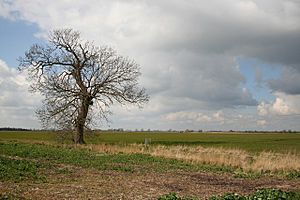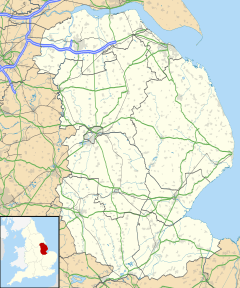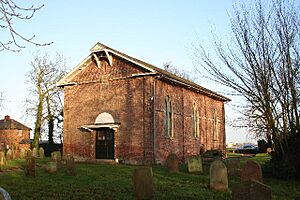Wildmore facts for kids
Quick facts for kids Wildmore |
|
|---|---|
 Wildmore Fen |
|
| Population | 547 (2011) |
| OS grid reference | TF247550 |
| • London | 110 mi (180 km) S |
| District | |
| Shire county | |
| Region | |
| Country | England |
| Sovereign state | United Kingdom |
| Post town | Lincoln |
| Postcode district | LN4 |
| Police | Lincolnshire |
| Fire | Lincolnshire |
| Ambulance | East Midlands |
| EU Parliament | East Midlands |
| UK Parliament |
|
Wildmore is a civil parish located in the East Lindsey area of Lincolnshire, England. It is about 9 miles (14 km) north-west of the town of Boston. It is also about 11 miles (18 km) south of Horncastle.
Wildmore is not a single village. Instead, it is a parish that includes the village of New York. It also contains the small settlement called Haven Bank.
Contents
Discovering Wildmore's Past
The name Wildmore comes from the large marshy area nearby, known as Wildmore Fen. After the Norman Conquest, Wildmore was part of important land areas. These areas were called baronies, and they included Bolingbroke, Horncastle, and Scrivelsby.
Early Land Ownership
A person named William Romara owned the Bolingbroke part of Wildmore. He gave his share to Kirkstead Abbey during the time of King Stephen.
King Henry I turned the entire fenland area into a royal forest. This meant it was used as the King's hunting grounds. This continued until 1230, during the reign of King Henry III.
Later, King Henry II gave parts of Wildmore to different people. He gave the Horncastle part to Gerbald Skalls. The Scrivelsby part went to Robert Marmion. Kirkstead Abbey received a special area called the Hermitage of Wildmore. Both Skalls and Marmion allowed the monks of Kirkstead to let their animals graze in Wildmore.
By 1222, the Abbot of Kirkstead was known as the Lord of Wildmore. He owned almost all of Wildmore. The only exception was a small area called Moorhouses, which belonged to Revesby Abbey.
Draining the Fen
Wildmore Fen was a very wet area for a long time. It was finally drained in 1802. This was part of a big project to drain the East, West, and Wildmore Fens. This project helped turn the marshy land into useful farmland.
How Wildmore Became a Parish
Wildmore officially became its own parish in 1880. It was formed from parts of many surrounding areas. These included West Ashby, Horncastle, Mareham on the Hill, Moorby, Roughton, Thimbleby, High Toynton, Low Toynton, and Wood Enderby. It also included parts of Bolingbroke, Coningsby, Haltham, Tattershall, Tattershall Thorpe, Thornton le Fen, Toynton All Saints, and Wilksby.
Local Landmarks
Wildmore is home to a historic church and a windmill. These buildings tell us about the area's past.
St Peter's Church
The church in Wildmore was built in 1816. It is made of red brick, sandstone, and limestone. It was once known as Frog Hall. This church is dedicated to Saint Peter. It is also a Grade II listed building, which means it is an important historical building.
Today, Saint Peter's Church is part of a group of churches called the Brothertoft Group. This group is also known as "Five in the Fen." It includes churches in nearby places like Brothertoft, Holland Fen, Kirton Holme, and Langrick.
Haven Bank Windmill
The Haven Bank Windmill was built in the early 1800s. It is made of red brick. Like the church, it is also a Grade II listed building. Windmills like this were once very important for grinding grain.



